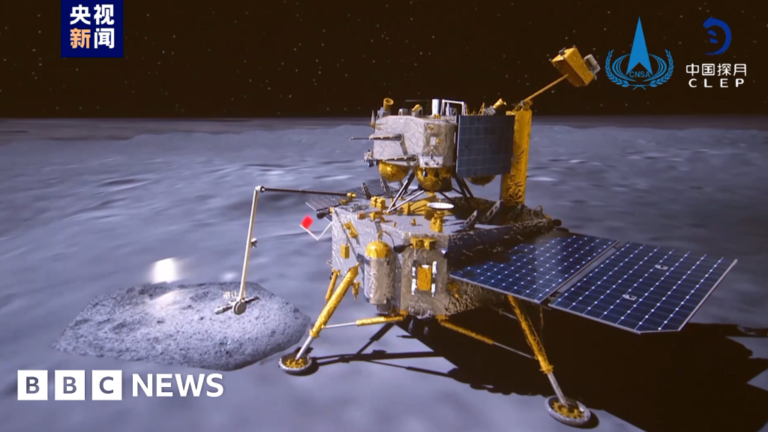China says its lunar probe has successfully lifted off from the far side of the Moon to begin its journey back to Earth, carrying the first-ever samples collected from that region.
According to state media, a module of the Chang’e-6 craft, named after the moon goddess in Chinese mythology, successfully took off on Tuesday at around 7:38 a.m. (Monday 11:38 p.m. GMT) to begin the journey of back.
The craft landed near the Moon’s south pole on Sunday, a world first celebrated by the international scientific community.
China is the only country to have landed on the far side of the Moon, having already done so in 2019.
The China National Space Administration called the mission “an unprecedented feat in human lunar exploration.”
This side of the Moon – which always faces Earth – is technically difficult to reach due to its rugged terrain and deep craters.
The Chinese mission aims to be the first to bring back rock and soil samples from the region, which scientists say could be very different from rock formations on the near side of the Moon.
State media published videos from China’s space agency showing the unmanned robot extending a small arm and waving the Chinese flag after collecting the precious samples.
On Tuesday, Chinese state media announced the module’s successful liftoff, citing the CNSA as saying the probe’s ascending module had “lifted off from the lunar surface.”
“The mission withstood the test of high temperatures on the far side of the Moon,” the space agency said.
After liftoff, the module then entered a “predefined orbit around the moon.”
The entire probe is expected to return in about three weeks to a landing site in Inner Mongolia.
Chinese scientists will have the first chance to analyze the rocks, and later, researchers around the world can also apply for this opportunity.
Scientists are excited about the samples China could collect. The probe could extract some of the Moon’s oldest rocks from a huge crater on its south pole.
The probe landed Sunday in a gigantic crater known as the South Pole-Aitken Basin. The crater is one of the largest known in the solar system.
The landing involved many risks, because it is very difficult to communicate with spacecraft once they reach the far side of the Moon.
Chinese space authorities described the operation as involving “many technical innovations, high risks and great difficulties.”
The mission aimed to collect around 2 kg (4.4 lb) of materials using a drill and a mechanical arm, according to the CNSA.
Experts previously told the BBC there was potential for new rocks.
“Everyone is very excited that we can look at these rocks that no one has ever seen before,” said Professor John Pernet-Fisher, who specializes in lunar geology at the University of Manchester.
He has already analyzed lunar rock brought back during the American Apollo mission and previous Chinese missions.
But he believes the ability to analyze rocks from a completely different area of the Moon could answer fundamental questions about planet formation.
The Moon’s South Pole is the next frontier for lunar missions – countries are keen to understand the region because there’s a good chance it contains ice.
Access to water would greatly increase the chances of successfully establishing a human base on the Moon for scientific research purposes.
This is the second time that China has launched a sample collection mission to the Moon.
In 2020, Chang’e-5 brought back 1.7 kg of material from an area called Oceanus Procellarum to the near side of the Moon.
In 2019, China became the first country to reach the far side with the landing of its Chang’e-4.
China plans three more uncrewed missions this decade to search for water on the Moon and establish a permanent base there.
Beijing’s broader strategy aims to see a Chinese astronaut walk on the Moon by around 2030.
The United States also aims to return astronauts to the Moon, with NASA aiming to launch its Artemis-3 mission in 2026.


